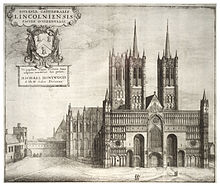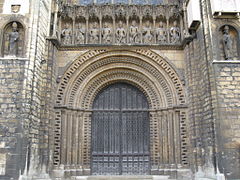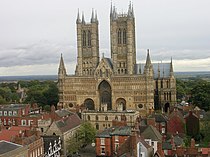Shipping from Europe with tracking number $20
Cathedral Gothic architecture medal 58mm by Famous
Jacob Wiener , born onin the village of Hoerstgen, Kamp-Lintfort , died onin Brussels , is a Belgian medalist . He produced numerous medals, coins and postage stamps, in particular the first Belgian postage stamp , put into circulation on.
Biography
When he was two years old, Jacob's family, which was Jewish and did not adopt the name Wiener (the Viennese) until 1808 , moved to Venlo in the Netherlands . His father is Marcus Mayer (1794-?) and his mother, Hanna Barruch (1791-?). Jacob, who is the eldest of a family of ten children, goes, at the age of thirteen, to his uncle, the renowned engraver Loeb Baruch, in Aix- la-Chapelle , to learn drawing, modeling and engraving.
In 1835 , he went to Paris to complete his training and, in 1839 , at the age of twenty-four, he settled permanently in Brussels and, a few years later, naturalized Belgian.
His first works drew attention to him, mainly a medal which represented the Sainte-Gudule church in Brussels. This was, for him, the starting point of an engraved reproduction of the main monuments of Europe, 41 in number (including 8 for France ) .
Popular favor attached to his name, and he was called upon to carry out important works such as the first Belgian postage stamps and the organization of their manufacture, the means of preventing fraud, the making of dies, etc. That of historical tokens for the Municipal Council of Brussels was also entrusted to him, as well as other works. He often worked in collaboration with his brothers Léopold and Charles Wiener , also medal engravers.
Wiener was, around 1870 , in full activity and at the height of his success when he felt the first expectations of his ardor, consequences of his indefatigable assiduity, of the prolonged and constant use of the magnifying glass: his sight gradually weakened and, in 1872, he became blind . However, after carrying out the cataract operation on both eyes, we managed to restore his sight more or less, but the healing was not complete and a relapse was still to be feared, he had to give up the practice of his art in 1874 1 .
Wiener survived twenty-five years at the end of his brilliant artistic career, but the Jewish community of Belgium, knowing his devotion to the confessional interests of his cult, gave him an important place in the management of their interests and ended up placing him at the head of their higher administration, a position he occupied laboriously and with dignity, surrounded until his last moments by the veneration of his colleagues.
Although a Knight of the Order of Leopold and of several other foreign orders, Jacques Wiener, former engraver to the King, President of the Israelite Central Consistory of Belgium , had formally renounced, out of simplicity and modesty, the military honors to which he was entitled. His burial took place in the cemetery of Ixelles 2 .
He was the husband of Annette Newton (1816-1891 ) , of English origin.
He was the father of Samson Wiener (born on August 18 , 1851 in Brussels and died there on April 10 , 1914 in a car accident), a lawyer and liberal French-speaking Brussels senator.
He was the grandfather of Ernest Wiener (Brussels 1882-1973): After studying at the Royal Military School , Ernest Wiener graduated as an electrical engineer from the Montefiore Institute . Seriously wounded on the front in 1918, after four years of combat, Major Wiener would become the director of the Royal Military School , then General-Major at Headquarters during the invasion of May 1940. Taken prisoner, he spent the war at the Stalag 3 , 4
Work

His first important achievement was a commemorative medal for the municipality of Venlo , ( Netherlands ) in 1840. In 1848, he won the contract for the engraving of the first Belgian postage stamp. He therefore took care of the composition and entrusted its engraving to John Henry Robinson . We see the King of the Belgians, Leopold I in military uniform, with clearly visible epaulets, hence the name Epaulettes given to this issue.
In 1845, he began to engrave medals for the exterior and interior of monuments, with great attention to detail accuracy, which was new: First a group of ten medals of Belgian churches, then the important monuments of Europe, cathedrals, churches, mosques, the Pantheon in Paris, the Saint-Sophie mosque in Istanbul, the dome of Pisa, the cathedrals of Cologne, Reims or Saint- Paul in London , but also all Belgian prisons and town halls 2 .
In 1859 he produced a medal of the Mosque-Cathedral of Cordoba , exhibited in the Victoria & Albert Museum 5 . Spain is becoming a popular destination for travellers, who discover traces of Muslim influence, in Cordoba, the Alhambra in Granada and the Alcazar in Seville .
Around 1864, he made a medal of the interior of the Hagia Sophia mosque in Constantinople , exhibited at the Victoria & Albert Museum 6 .
In 1872, his eyesight declining, he ceased to produce medals.
Lincoln Cathedral
| Lincoln Cathedral | |
|---|---|
| The Cathedral Church of the Blessed Virgin Mary of Lincoln | |
 Lincoln Cathedral viewed from Lincoln Castle | |
| Location | Lincoln, Lincolnshire |
| Country | England |
| Denomination | Church of England |
| Previous denomination | Roman Catholicism |
| Tradition | Anglo-Catholic |
| Website | lincolncathedral |
| History | |
| Dedication | Virgin Mary |
| Consecrated | 11 May 1092 |
| Architecture | |
| Style | Gothic |
| Years built | 1185–1311 |
| Groundbreaking | 1072[1] |
| Specifications | |
| Length | 147 metres (482 ft) |
| Width | 24 metres (78 ft) |
| Nave height | 24 metres (78 ft) |
| Number of towers | 3 |
| Tower height | 83 metres (272 ft) (crossing) |
| Number of spires | 3 (now lost) |
| Spire height | 160 metres (520 ft) (crossing tower) |
| Bells | 13 hung for change ringing; 20 in total (13 in South West tower, 2 in North West tower and 5 in the central tower) |
| Tenor bell weight | 23cwt 3qr 23lb (1212kg) in D |
| Administration | |
| Province | Canterbury |
| Diocese | Lincoln (since 1072) |
| Clergy | |
| Dean | Christine Wilson |
| Precentor | Nick Brown |
| Chancellor | Paul Overend |
| Laity | |
| Director of music | Aric Prentice |
| Organist(s) | Jeffrey Makinson |
| Chapter clerk | William Harrison |
| Building details | |
 | |
| Record height | |
| Tallest in the world from 1311 to 1548[I] | |
| Preceded by | Great Pyramid of Giza |
| Surpassed by | Tower of St. Mary's Church, Stralsund |
Lincoln Cathedral, Lincoln Minster, or the Cathedral Church of the Blessed Virgin Mary of Lincoln and sometimes St Mary's Cathedral, in Lincoln, Lincolnshire, England. It is a Grade I listed cathedral and is the seat of the Anglican Bishop of Lincoln. Construction commenced in 1072 and continued in several phases throughout the High Middle Ages. Like many of the medieval cathedrals of England, it was built in the Early Gothic style.
Lincoln Cathedral became the tallest building in the world upon the completion of its 160 metres (525 ft) high central spire in 1311. It was the first building to hold that title since the Great Pyramid of Giza, and held it for 238 years until the spire collapsed in 1548,[2][3][4] and was not rebuilt. Had the central spire remained intact, Lincoln Cathedral would have remained the world's tallest structure until the completion of the Washington Monument in 1884. For hundreds of years the cathedral held one of the four remaining copies of the original Magna Carta, now securely displayed in Lincoln Castle. The cathedral is the fourth largest in the UK (in floor area) at around 5,000 square metres (54,000 sq ft), after Liverpool, St Paul's and York Minster.[5] It is highly regarded by architectural scholars; the Victorian writer John Ruskin declared: "I have always held ... that the cathedral of Lincoln is out and out the most precious piece of architecture in the British Isles and roughly speaking worth any two other cathedrals we have."[6]
History
Remigius de Fécamp, the first Bishop of Lincoln, moved the episcopal seat (cathedra) there "some time between 1072 and 1092".[7] About this, James Essex writes that "Remigius ... laid the foundations of his Cathedral in 1072" and "it is probable that he, being a Norman, employed Norman masons to superintend the building ... though he could not complete the whole before his death."[8]
Before that, writes B Winkles, "It is well known that Remigius appropriated the parish church of St Mary Magdalene in Lincoln, although it is not known what use he made of it."[9]
When Lincoln Cathedral was first built, William the Conqueror granted the parish of Welton to Remigius in order to endow six prebends which provided income to support six canons attached to the cathedral. These were subsequently confirmed by William II and Henry I.[10]


Until then St Mary's Church in Stow was considered to be the "mother church"[11] of Lincolnshire[12] (although it was not a cathedral, because the seat of the diocese was at Dorchester Abbey in Dorchester-on-Thames, Oxfordshire). However, Lincoln was more central to a diocese that stretched from the Thames to the Humber.
Remigius built the first Lincoln Cathedral on the present site, finishing it in 1092 and then dying on 7 May of that year,[13] two days before it was consecrated. In 1124, the timber roofing was destroyed in a fire. Alexander (bishop, 1123–48) rebuilt and expanded the cathedral, but it was mostly destroyed by an earthquake about forty years later, in 1185 (dated by the British Geological Survey as occurring 15 April 1185).[9][14] The earthquake was one of the largest felt in the UK: it has an estimated magnitude of over 5. The damage to the cathedral is thought to have been very extensive: the cathedral is described as having "split from top to bottom"; in the current building, only the lower part of the west end and its two attached towers remain of the pre-earthquake cathedral.[14]
Some (Kidson, 1986; Woo, 1991) have suggested that the damage to Lincoln Cathedral was probably exacerbated by poor construction or design, with the actual collapse most probably caused by a vault failure.[14]
After the earthquake, a new bishop was appointed. He was Hugh de Burgundy of Avalon, France, who became known as St Hugh of Lincoln. He began a massive rebuilding and expansion programme. With his appointment of William de Montibus as master of the cathedral school and chancellor, Lincoln briefly became one of the leading educational centres in England, producing writers such as Samuel Presbiter and Richard of Wetheringsett, though it declined in importance after William's death in 1213.[15] Rebuilding began with the choir (St Hugh's Choir) and the eastern transepts between 1192 and 1210.[16] The central nave was then built in the Early English Gothic architectural style. Lincoln Cathedral soon followed other architectural advances of the time – pointed arches, flying buttresses and ribbed vaulting were added to the cathedral. This allowed support for incorporating larger windows. There are thirteen bells in the south-west tower, two in the north-west tower, and five in the central tower (including Great Tom). Accompanying the cathedral's large bell, Great Tom of Lincoln, is a quarter-hour striking clock which was installed in the early 19th century.[17] The two large stained glass rose windows, the matching Dean's Eye and the Bishop's Eye were added to the cathedral during the late Middle Ages. The former, the Dean's Eye in the north transept dates from the 1192 rebuild begun by St Hugh, completed in 1235. The latter, the Bishop's Eye, in the south transept was reconstructed a hundred years later in 1330.[18] A contemporary record, “The Metrical Life of St Hugh”, refers to the meaning of these two windows (one on the dark, north, side and the other on the light, south, side of the building):
"For north represents the devil, and south the Holy Spirit and it is in these directions that the two eyes look. The bishop faces the south in order to invite in and the dean the north in order to shun; the one takes care to be saved, the other takes care not to perish. With these Eyes the cathedral's face is on watch for the candelabra of Heaven and the darkness of Lethe (oblivion)."


| External video | |
|---|---|
 | |
After the additions of the Dean's eye and other major Gothic additions it is believed some mistakes in the support of the tower occurred, for in 1237 the main tower collapsed. A new tower was soon started and in 1255 the cathedral petitioned Henry III to allow them to take down part of the town wall to enlarge and expand the cathedral, including the rebuilding of the central tower and spire. They replaced the small rounded chapels (built at the time of St Hugh) with a larger east end to the cathedral. This was to handle the increasing number of pilgrims to the cathedral, who came to worship at the shrine of Hugh of Lincoln.
In 1290 Eleanor of Castile died and King Edward I of England decided to honour her, his Queen Consort, with an elegant funeral procession. After her body had been embalmed, which in the 13th century involved evisceration, Eleanor's viscera were buried in Lincoln cathedral and Edward placed a duplicate of the Westminster Abbey tomb there. The Lincoln tomb's original stone chest survives; its effigy was destroyed in the 17th century and replaced with a 19th-century copy. On the outside of Lincoln Cathedral are two prominent statues often identified as Edward and Eleanor, but these images were heavily restored in the 19th century and they were probably not originally intended to depict the couple.[20]
Between 1307 and 1311 the central tower was raised to its present height of 271 feet (83 m). The western towers and front of the cathedral were also improved and heightened. At this time, a tall lead-encased wooden spire topped the central tower but was blown down in a storm in 1548. With its spire, the tower reputedly reached a height of 525 feet (160 m) (which would have made it the world's tallest structure, surpassing the Great Pyramid of Giza, which held the record for almost 4,000 years). Although still doubted,[2] this is the height agreed upon by the majority of historians.[21][22][23][disputed ]
Other additions to the cathedral at this time included its elaborate carved screen and the 14th-century misericords, as was the Angel Choir. For a large part of the length of the cathedral, the walls have arches in relief with a second layer in front to give the illusion of a passageway along the wall. However the illusion does not work, as the stonemason, copying techniques from France, did not make the arches the correct length needed for the illusion to be effective.[citation needed]
In 1398 John of Gaunt and Katherine Swynford founded a chantry in the cathedral to pray for the welfare of their souls. In the 15th century the building of the cathedral turned to chantry or memorial chapels. The chapels next to the Angel Choir were built in the Perpendicular style, with an emphasis on strong vertical lines, which survive today in the window tracery and wall panelling.
Magna Carta[edit]
Hugh of Wells, Bishop of Lincoln, was one of the signatories to Magna Carta and for hundreds of years the cathedral held one of the four remaining copies of the original, now securely displayed in Lincoln Castle.[24]
The Lincoln Magna Carta was on display at the British Pavilion during the 1939 New York World's Fair.[25] In March 1941, the Foreign Office proposed that the Lincoln Magna Carta be gifted to the United States, citing the "many thousands of Americans who waited in long queues to view it" and the US passage of the Lend-Lease Act, among other reasons.[25] In 2009 the Lincoln Magna Carta was lent to the Ronald Reagan Presidential Library in Simi Valley, California.[24]
There are three other surviving copies: two at the British Library and one at Salisbury Cathedral.[26]
Little Saint Hugh[edit]
In August 1255 the body of an eight-year-old boy was found in a well in Lincoln. He had been missing for nearly a month. This incident became the source of a blood libel in the city, with Jews accused of his abduction, torture, and murder. Many Jews were arrested and eighteen were hanged. The boy became known as Little Saint Hugh, to distinguish him from Saint Hugh of Lincoln, but he was never canonised.
The cathedral benefited from these events because Hugh was seen as a martyr, and many devotees came to the city and cathedral to venerate him. Geoffrey Chaucer mentions the case in "The Prioress's Tale" and a ballad was written about it in 1783. In 1955 a plaque was placed near "the remains of the shrine of 'Little St Hugh'" in the cathedral, that decries the "Trumped up stories of 'ritual murders' of Christian boys by Jewish communities."
